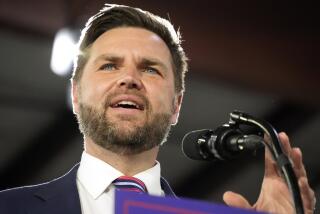Fine Art of Politicking, Sistine-Style
When Pope John Paul II created 30 new cardinals last Tuesday, many observers regarded it as the ailing pontiff’s last chance to shape the group of men who will elect his successor. Though no one knows how much time John Paul II has left -- and this is a man with a history of outliving predictions of his demise -- there’s a sense that the campaign season for choosing his successor has begun.
The race for the papacy is unlike secular politics. There are no bumper stickers or posters, no campaign platforms, no polls or focus groups, no candidate debates. Balloting is held not in a voting booth but a “conclave.” The term is built from the Latin phrase “with a key,” referring to the fact that cardinals are locked behind closed doors in the Sistine Chapel.
If the election were held today, the electorate would be a group of 135 men who range in age from 51 to 79 (a cardinal has to be under 80 to participate), with roughly half from Europe, just under a third from Latin America and the rest evenly divided among Africa, Asia and North America.
Although John Paul has appointed all but five of the cardinals eligible to choose his successor, he has not stacked the deck -- not everyone in the College of Cardinals shares his theological or political agenda. In fact, there are at least four identifiable “parties,” or bodies of opinion, and the jockeying among them will shape the politics of the next papal election.
They are:
* The Border Patrol. Doctrinal conservatives bent on policing the theological boundaries between the Roman Catholic Church and the rest of the world. For example, this group has reservations about interfaith dialogues, which lead to suggestions that Catholicism is just one valid choice among others.
* The Reform Party. Moderate-to-progressive cardinals interested in continuing the internal church reforms of the Second Vatican Council (1962-65), such as decentralization of power and the promotion of the laity.
* The Social Justice Party. Cardinals whose passion lies outside the church in issues such as debt relief, war and peace, and the struggle to “humanize” globalization.
* The Integralists. Cardinals who want to see civil law based on church teaching (especially on issues such as abortion and reproductive technology) and who want state funding for church operations. Italy, where the church enjoys substantial state support and an informal veto over social policy, is one model.
None of these interest groups enjoys a two-thirds majority, which means that no one of them can force an election of a pope on its own. (The rules allow the cardinals to elect a pope with a simple majority after roughly 30 ballots, but it’s unlikely they would reach this stage.) Hence compromise and trade-offs become essential.
Traditionally, cardinals use the following criteria to size up potential popes: geography, age, life experience, position on issues, languages, charisma and holiness. Many cardinals, for example, believe a Third World pope would help resolve conflicts between industrialized and developing states, as well as be a recognition that two-thirds of Catholics today are in developing countries.
In fact, because a majority of cardinals are interested in social issues and because two-thirds come from outside Italy, a viable compromise candidate might come from the developing world, be in his 60s, head a diocese (rather than work within the Vatican) and be a doctrinal moderate-to-conservative with a focus outside the church. He should speak Italian, English and Spanish at least, have a visibly deep prayer life and obvious personal integrity. Electing a non-European would be unprecedented, but bear in mind that cardinals in the Third World tend to be more traditional, and hence more appealing to the church, than their European counterparts.
Who could meet the compromise bill?
Three Latin American cardinals make many observers’ lists.
* Claudio Hummes, 69, of Sao Paolo, Brazil: A Franciscan, Hummes is a moderate but safe on doctrinal questions, a champion of social justice (he is a backer of Brazil’s progressive president) and a unifier.
* Oscar Rodriguez Maradiaga, 60, of Tegucigalpa, Honduras: A smiling, multilingual, dynamic man, Rodriguez is a passionate voice for the poor. He won the confidence of conservative cardinals by attacking the U.S. media for their coverage of the American sex abuse crisis.
* Jorge Mario Bergoglio, 66, of Buenos Aires: A Jesuit, Bergoglio is an intellectual as well as a pastor, and he became a national point of reference during Argentina’s economic crisis. He’s known for his humility, preferring public transportation to chauffeurs and limousines.
It’s impossible to say, of course, whether one of these men will actually become the successor of Peter. The trash heaps of church history are littered with the carcasses of journalists who have tried to predict the next pope. Conclaves produce surprises, because the cardinals never simply clone the pope who appointed them; they seek a candidate who can correct that pope’s excesses and meet the challenges he could not. Hence a successor is likely to be a different sort of man.
Or, as the Italians put it: You always follow a fat pope with a thin one.
John L. Allen Jr. is the Vatican correspondent of the National Catholic Reporter and author of “Conclave: The Politics, Personalities and Process of the Next Papal Election” (Doubleday, 2002 ).
More to Read
Sign up for Essential California
The most important California stories and recommendations in your inbox every morning.
You may occasionally receive promotional content from the Los Angeles Times.









